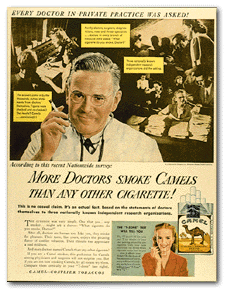Main Menu · Search · Current Issue · Contact · Archives · Centennial · Letters to the Editor · FAQs
![]()
Main Menu · Search · Current Issue · Contact · Archives · Centennial · Letters to the Editor · FAQs

| Gone Fission | High Flying |
| Harvard Men as Alcoholics | Bacterial Revenge |
| The Fall of the House of Ashes? | Cuisine Before Forks |
| E-mail and Web Information | |

![]()
In 1929 a band of glamorous Manhattan debutantes marched down Fifth Avenue brandishing "torches of freedom" amid the Easter Day Parade. Reporters jumped on the story. Society matrons censured the breakdown of age-old customs. Feminists acclaimed the gesture as a sign of social gains. Were these young women demanding equal rights with fiery replicas of the Statue of Liberty? Not exactly. The "torches of freedom" were, in fact, Lucky Strike cigarettes.
This savvy publicity stunt combined "the symbol of the emancipated flapper and the symbol of the committed feminist," says Allan Brandt, Kass professor of the history of medicine and professor of the history of science. In a recent article in the Journal of the American Medical Women's Association, Brandt describes such public relations coups by tobacco companies. These "events" aimed to induce more women to smoke-and to smoke in public. Eventually they helped double the size of the female cigarette market.
The tobacco industry's manipulation of the cigarette's "remarkably elastic set of meanings" fueled its rapid rise in the first half of the twentieth century. Brandt writes: "For men, the cigarette evoked images of power, authority, and independence; for women, it represented rebellious independence, glamour, seduction, and sexual allure."
Cigarette smoke had previously conjured a different set of meanings. "Before the 1900s, the cigarette was viewed as effeminate, a cheap and stigmatized form of tobacco consumption," Brandt says. Victorian values scorned many forms of self-indulgence, but the rise of the consumer society changed all that. "The worst thing you could say about someone in the 1870s was that they were indulgent and pleasure-seeking," Brandt asserts. "But by 1930, tobacco ads were saying, 'Indulge in a Lucky, the most pleasurable cigarette.'"
The ubiquitous mass-produced cigarette is a twentieth-century phenomenon. A hundred years ago, almost no Americans smoked cigarettes. But between 1900 and 1965 yearly cigarette consumption rose from fewer than 50 per capita to well over 4,000. In his forthcoming book, The Rise and Fall of the Cigarette, Brandt cites forces ranging from the portable safety match to the culture of consumption to explain this astounding growth in popularity.
He also offers a guided tour through the history of biomedical epistemology. "Our way of proving something today is different than it was in 1900," Brandt explains. Early objections to smoking did not distinguish between moral and health hazards. The "dirty habit," like alcohol, "was associated with idleness, immorality, and sin," he writes. Women's groups "encouraged young women to pledge abstinence from tobacco, as well as from jazz dancing and petting." A prominent anti-cigarette crusader, Henry Ford, founded a national journal called The Case against the Little White Slaver. "With every breath of cigarette smoke," declared Ford, "they inhale imbecility and exhale manhood."
"By the late 1920s," Brandt writes in another article, "researchers began to focus more precisely on the specific health consequences of smoking." The increasing prevalence of cancer and heart disease forced the medical sciences to formulate new models of causality. Brandt recounts the pitched battle between older, "lab bench" modes of proof-which could not "see" the cancerous effects of smoking-and the upstart field of modern epidemiology and statistical inference. The 1964 Surgeon General's Report on Smoking and Health effectively declared the triumph of epidemiology.
Earlier tobacco counterattacks-like a '40s ad campaign that trumpeted, "More Doctors Smoke Camels Than Any Other Cigarette!"-were suddenly unthinkable. "The cigarette is now a highly stigmatized product," Brandt says, citing the precipitous drop-from 42 to 26 percent-in U.S. adult smoking prevalence between 1964 and 1989. He believes that the key to the cigarette's reversal of fortune has been the passive smoking argument. "We Americans are tolerant of risks that we assume, but intolerant of risks that are imposed on us. Smoking had been defined as a public behavior. Now it was being defined as anti-public."
Yet Brandt is loath to declare that the cigarette is dead. "On the one hand, the government is suggesting that smoking is hazardous," he says. "On the other hand, it subsidizes tobacco agriculture and has actively worked to open new markets to the tobacco industry. It's tragic, because the United States is playing a role in what will be a worldwide pandemic. The World Health Organization predicts 2 million smoking-related deaths every year over the next 10 years-1 million deaths per year in China alone. In that sense, I mean the 'fall of the cigarette' to be ironic."
Harbour Fraser Hodder
Main Menu · Search · Current Issue · Contact · Archives · Centennial · Letters to the Editor · FAQs
![]()
Harvard Magazine · 7 Ware Street · Cambridge, MA 02138 · Phone (617) 495-5746